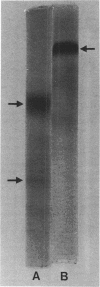Abstract
Two serine transhydroxymethylase activities have been purified from a facultative methylotrophic bacterium. One enzyme predominates when the organism is grown on methane or methanol as the sole carbon and energy source, whereas the second enzyme is the major isoenzyme found when succinate is used as the sole carbon and energy source. The enzyme from methanol-grown cells is activated by glyoxylate, is not stimulated by Mg2+, Mn2+, or Zn2+, and has four subunits of 50,000 molecular weight each. The enzyme from succinate-grown cells is not activated by glyoxylate and is stimulated by Mg2+, Mn2+, and Zn2+, and sodium dodecyl sulfate-acrylamide gel electrophoresis indicates that this enzyme has subunit molecular weight of 100,000, the same as the molecular weight obtained for the active enzyme. Cells grown in the presence of both methanol and succinate incorporate less methanol carbon per unit time than cells grown on methanol and have a lower specific activity of the glyoxylate-activated enzyme than methanol-grown cells. Adenine, glyoxylate, or trimethoprim in the growth medium causes an increased level of serine transhydroxymethylase in both methanol- and succinate-grown cells by stimulating the synthesis of the glyoxylate-activated enzyme.
Full text
PDF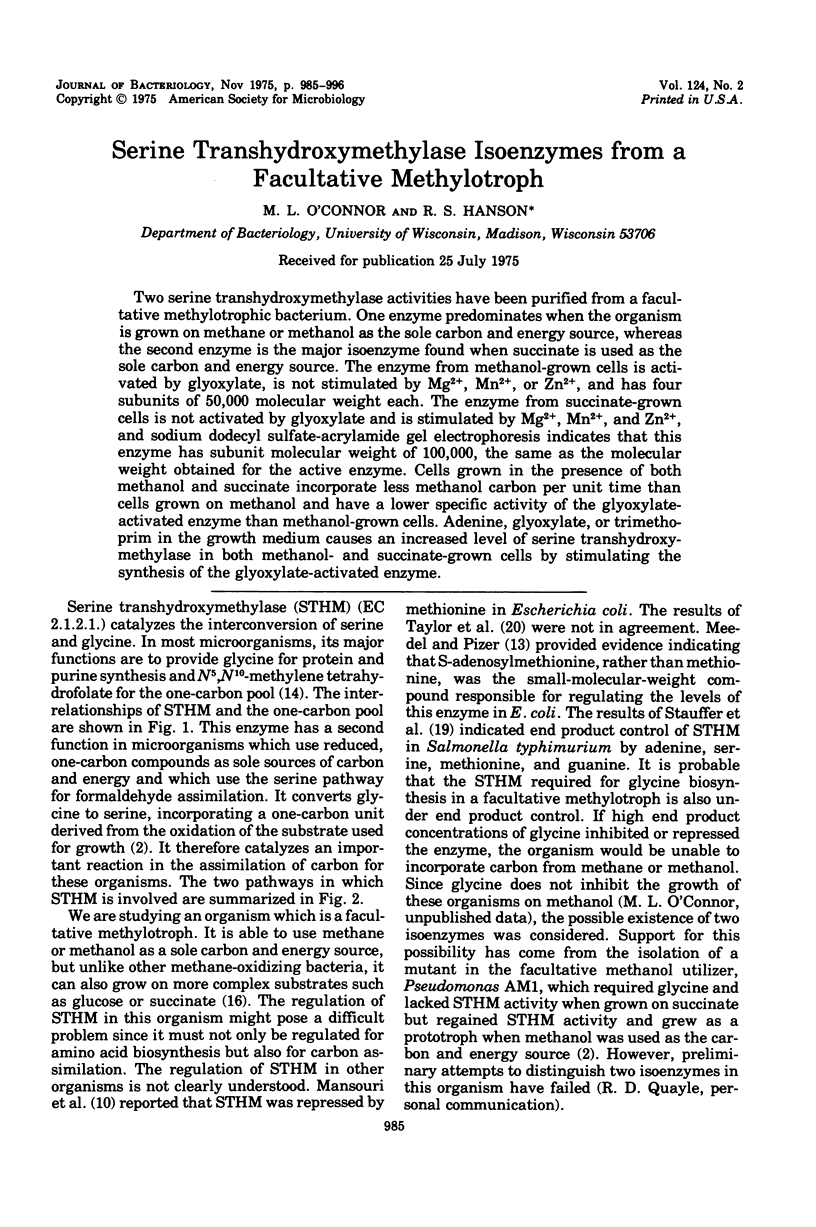

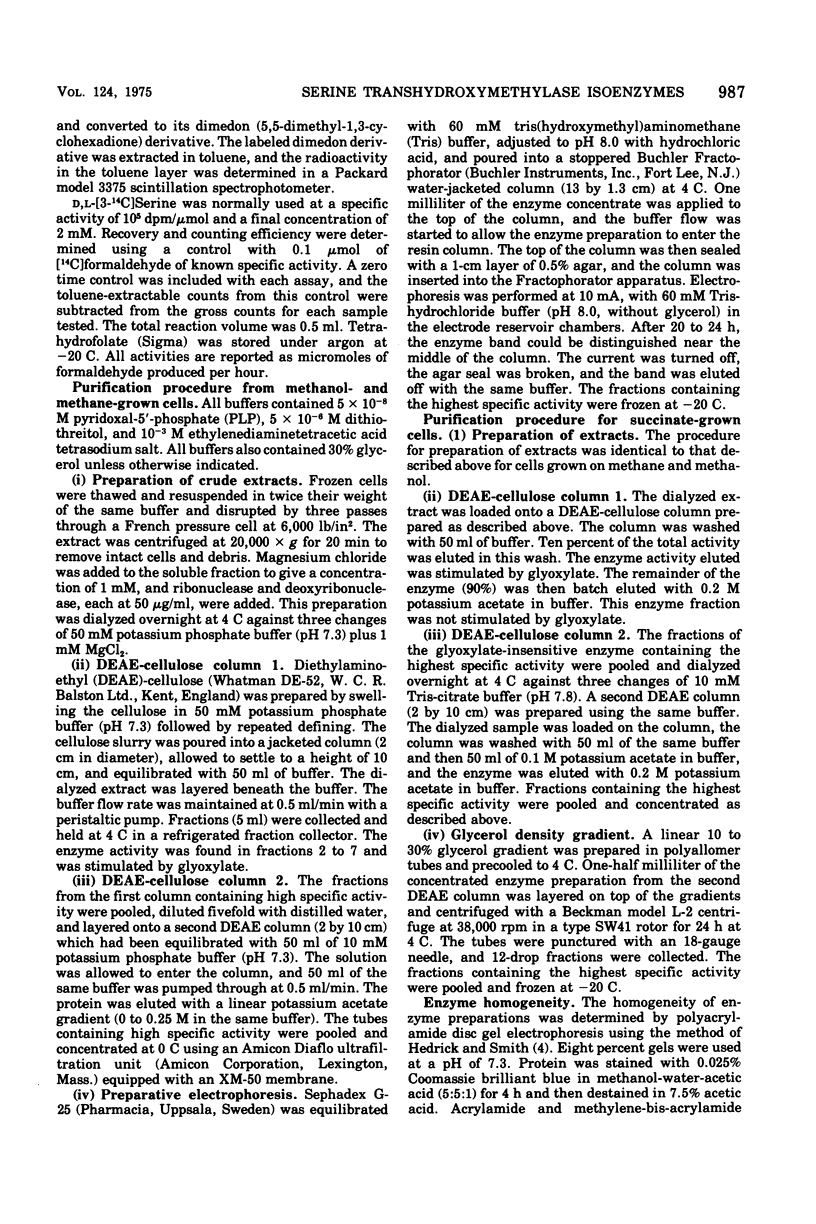

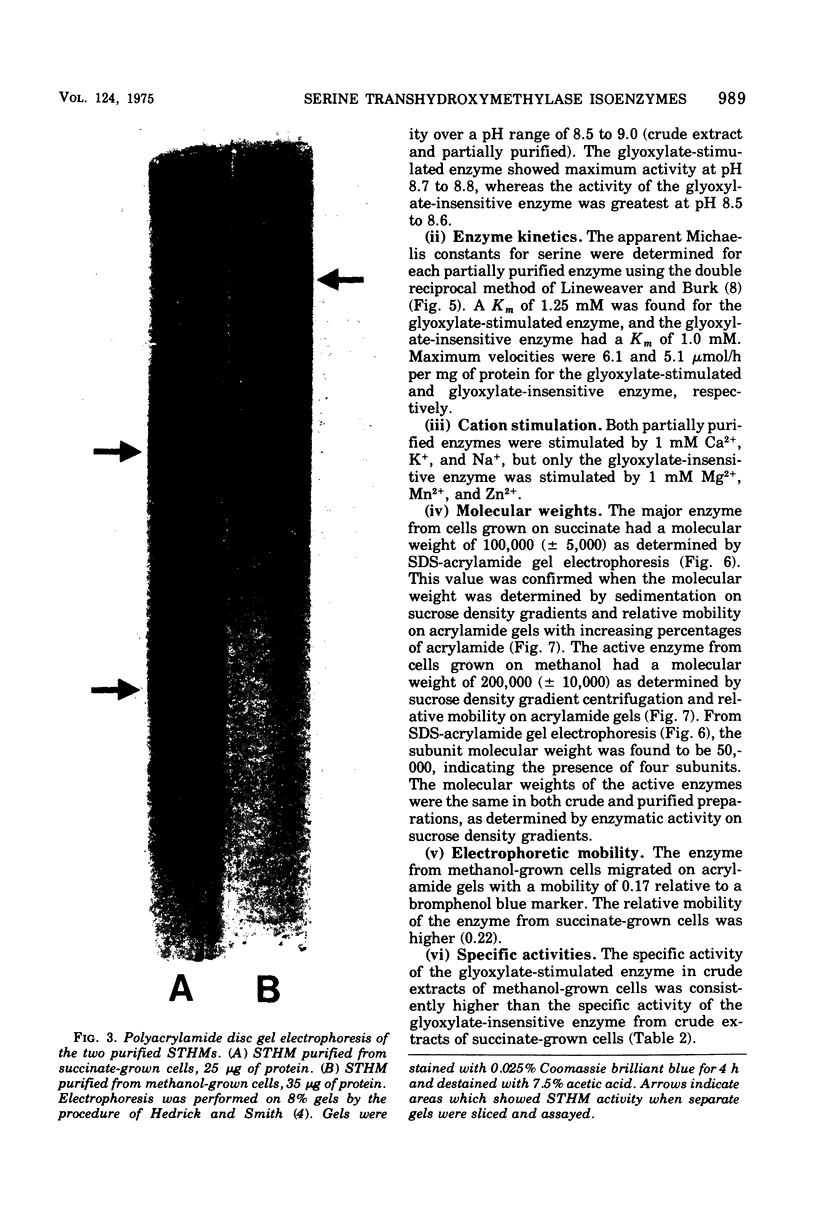
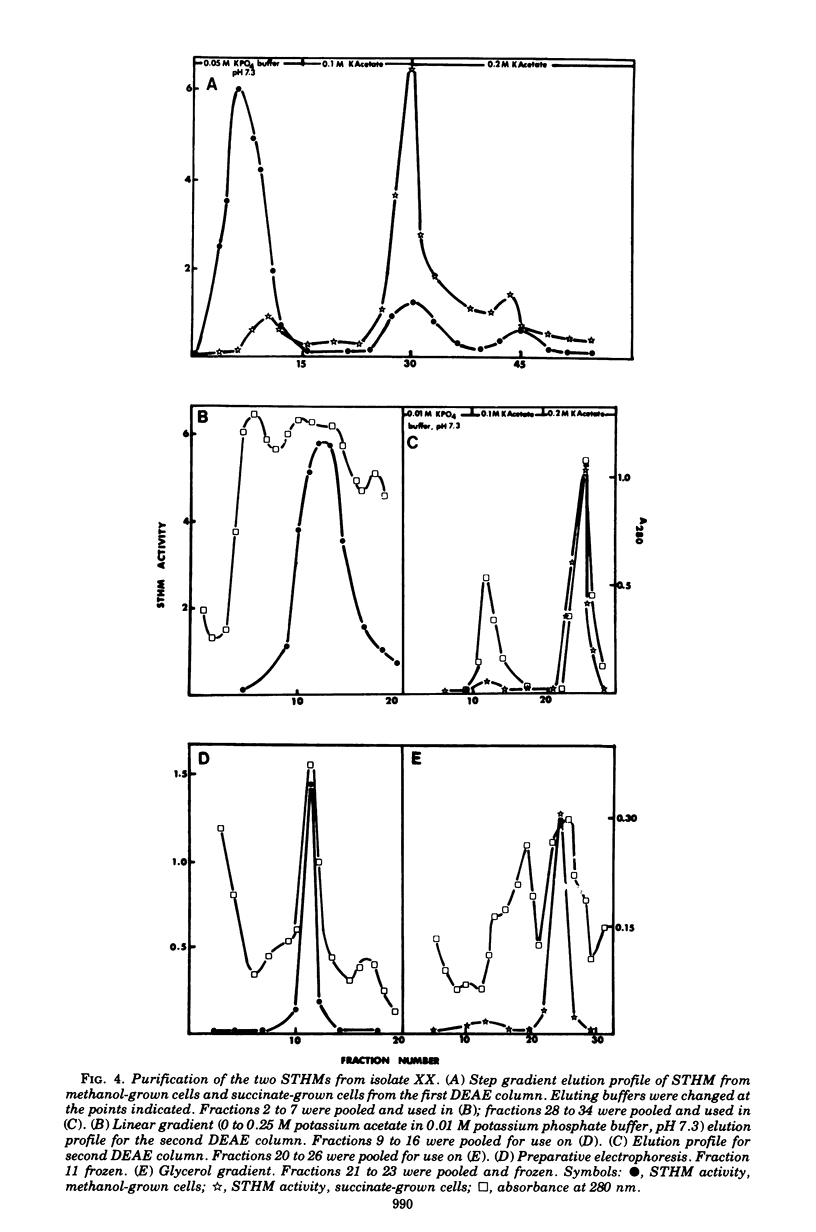


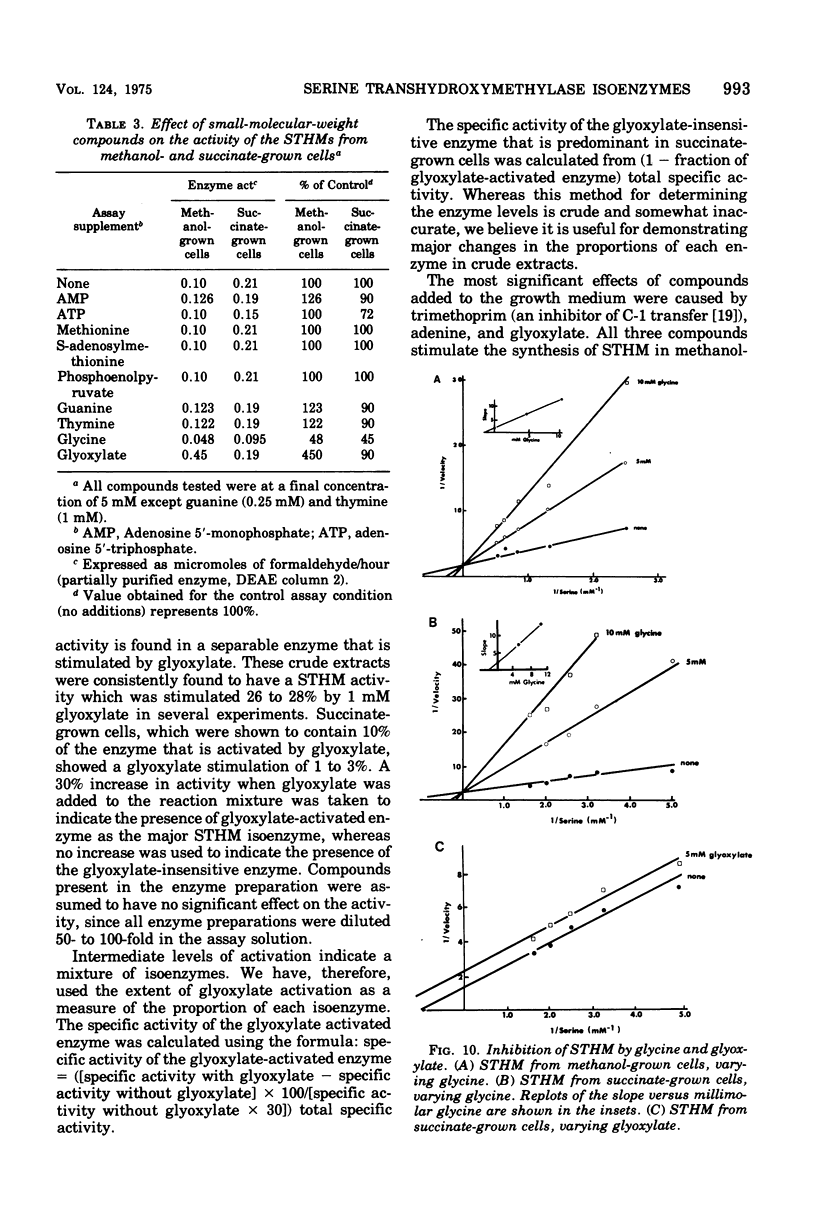

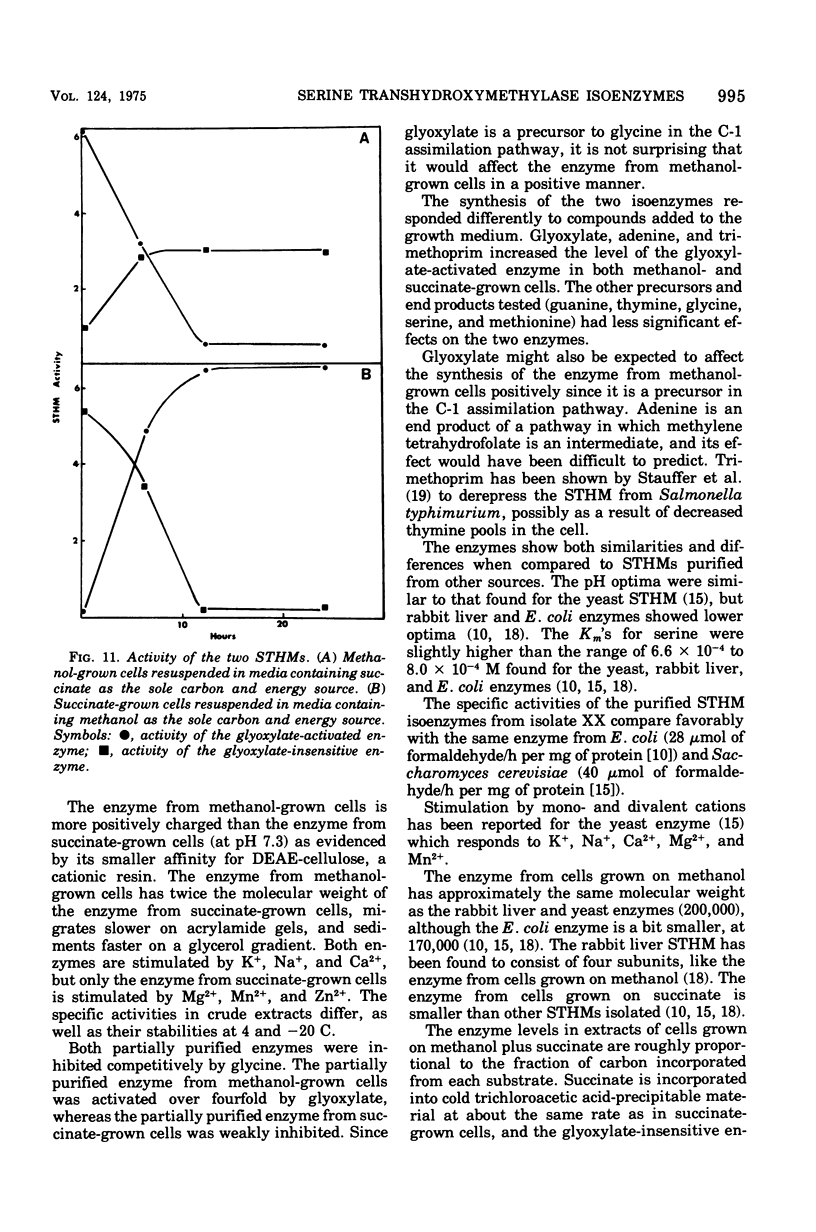

Images in this article
Selected References
These references are in PubMed. This may not be the complete list of references from this article.
- HARRIS I. STRUCTURE AND CATALYTIC ACTIVITY OF ALCOHOL DEHYDROGENASES. Nature. 1964 Jul 4;203:30–34. doi: 10.1038/203030a0. [DOI] [PubMed] [Google Scholar]
- Harder W., Quayle J. R. The biosynthesis of serine and glycine in Pseudomonas AM1 with special reference to growth on carbon sources other than C1 compounds. Biochem J. 1971 Mar;121(5):753–762. doi: 10.1042/bj1210753. [DOI] [PMC free article] [PubMed] [Google Scholar]
- Hedrick J. L., Smith A. J. Size and charge isomer separation and estimation of molecular weights of proteins by disc gel electrophoresis. Arch Biochem Biophys. 1968 Jul;126(1):155–164. doi: 10.1016/0003-9861(68)90569-9. [DOI] [PubMed] [Google Scholar]
- Kiselev N. A., Shpitzberg C. L., Vainshtein B. K. Crystallization of catalase in the form of tubes with monomolecular walls. J Mol Biol. 1967 May 14;25(3):433–441. doi: 10.1016/0022-2836(67)90196-9. [DOI] [PubMed] [Google Scholar]
- LOWRY O. H., ROSEBROUGH N. J., FARR A. L., RANDALL R. J. Protein measurement with the Folin phenol reagent. J Biol Chem. 1951 Nov;193(1):265–275. [PubMed] [Google Scholar]
- Laemmli U. K. Cleavage of structural proteins during the assembly of the head of bacteriophage T4. Nature. 1970 Aug 15;227(5259):680–685. doi: 10.1038/227680a0. [DOI] [PubMed] [Google Scholar]
- MARTIN R. G., AMES B. N. A method for determining the sedimentation behavior of enzymes: application to protein mixtures. J Biol Chem. 1961 May;236:1372–1379. [PubMed] [Google Scholar]
- Mansouri A., Decter J. B., Silber R. Studies on the regulation of one-carbon metabolism. II. Repression-derepression of serine hydroxymethyltransferase by methionine in Escherichia coli 113-3. J Biol Chem. 1972 Jan 25;247(2):348–352. [PubMed] [Google Scholar]
- Martinez-Carrion M., Critz W., Quashnock J. Molecular weight and subunits of serine transhydroxymethylase. Biochemistry. 1972 Apr 25;11(9):1613–1615. doi: 10.1021/bi00759a011. [DOI] [PubMed] [Google Scholar]
- Meedel T. H., Pizer L. I. Regulation of one-carbon biosynthesis and utilization in Escherichia coli. J Bacteriol. 1974 Jun;118(3):905–910. doi: 10.1128/jb.118.3.905-910.1974. [DOI] [PMC free article] [PubMed] [Google Scholar]
- Nakamura K. D., Trewyn R. W., Parks L. W. Purification and characterization of serine transhydroxy-methylase from Saccharomyces cerevisiae. Biochim Biophys Acta. 1973 Dec 19;327(2):328–335. doi: 10.1016/0005-2744(73)90415-4. [DOI] [PubMed] [Google Scholar]
- Patt T. E., Cole G. C., Bland J., Hanson R. S. Isolation and characterization of bacteria that grow on methane and organic compounds as sole sources of carbon and energy. J Bacteriol. 1974 Nov;120(2):955–964. doi: 10.1128/jb.120.2.955-964.1974. [DOI] [PMC free article] [PubMed] [Google Scholar]
- Richter G. W., Walker G. F. Reversible association of apoferritin molecules. Comparison of light-scattering and other data. Biochemistry. 1967 Sep;6(9):2871–2880. doi: 10.1021/bi00861a031. [DOI] [PubMed] [Google Scholar]
- Schirch L. V., Diller A. Serine transhydroxymethylase. Affinity of the active site for substrates, substrate analogues, and anions. J Biol Chem. 1971 Jun 25;246(12):3961–3966. [PubMed] [Google Scholar]
- Stauffer G. V., Baker C. A., Brenchley J. E. Regulation of serine transhydroxymethylase activity in Salmonella typhimurium. J Bacteriol. 1974 Dec;120(3):1017–1025. doi: 10.1128/jb.120.3.1017-1025.1974. [DOI] [PMC free article] [PubMed] [Google Scholar]
- Taylor R. T., Dickerman H., Weissbach H. Control of one-carbon metabolism in a methionine-B12 auxotroph of Escherichia coli. Arch Biochem Biophys. 1966 Nov;117(2):405–412. doi: 10.1016/0003-9861(66)90429-2. [DOI] [PubMed] [Google Scholar]
- Weber K., Osborn M. The reliability of molecular weight determinations by dodecyl sulfate-polyacrylamide gel electrophoresis. J Biol Chem. 1969 Aug 25;244(16):4406–4412. [PubMed] [Google Scholar]



